Kilcor Castle
Houses within 10km of this house
Displaying 62 houses.
Houses within 10km of Kilcor Castle
Displaying 62 houses.
| House name | Description | |
|---|---|---|
| Aghern/Ahern House | Brabazon Esq was resident in the 1770s and 1780s. The home of Spotswood Bowles in the first half of the 19th century. The buildings were valued at £47+ in the early 1850s and held from the representatives of William Beamish. Spotswood died in 1864 and was succeeded by his son George who was in turn succeeded by his nephew Spotswood in 1886. Relatives of the Bowles owned this property until the 1970s. In 1942 the Irish Tourist Association Survey mentions the ruins of Aghern Castle in the grounds of Mrs. Spotswood Bowles property. Aghern was uninhabited for a time but has recently been restored. |

|
| Kilshannig | This house was built for Abraham Devonsher, a Cork banker and Member of Parliament, in the 1760s. It remained the home of the Devonsher family until sold to Edward Roche, father of the 1st Earl of Fermoy, pre 1837. Lewis records it as the winter residence of the Roche family. At the time of Griffith's Valuation it was occupied by James Kelly of Cahircon, son-in-law of Edward Roche, and valued at £58+. In 1943 the Irish Tourist Association Survey mentioned that it was the home of the McVeigh family. The Sardinian architect, Davis Ducart, designed this house and according to the Irish Georgian Society it is considered one of the very finest Palladian houses in Ireland. The Society is currently supporting the restoration of parts of this house. see http://www.igs.ie/Programmes/Conservation-Grants/Kilshannig.aspx |

|
| Rockville | At the time of Griffith's Valuation occupied by Michael Mockler and held from the representatives of Matthew Hendly, the buildings were valued at £26. The Mocklers advertised the sale of their interest in July 1851 and July 1853. The sale rental records the lease of Rockville by Ferguson Hendley to the Reverend James Mockler for 3 lives in July 1841 and that £2,000 had been spent on the house. Caroline Bourke occupied a mansion house with 37 acres in the townland of Licklash in 1906. It was valued at £60. In the 1870s Michael Bourke of Lecklash owned 37 acres. This house later became a summer home of Sir Oswald Mosley. Also known as Isleclash House. |
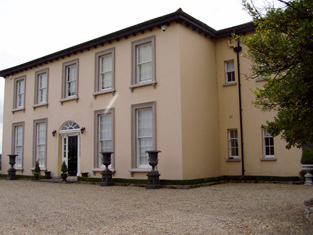
|
| Richmond | Located in the town of Fermoy, Richmond was occupied by H. Smyth in 1837 and by George Walker. It was the residence of the Furlong family in the second half of the 19th century. In the 1920s they sold the house to the Loreto Sisters. Still part of the convent complex at the beginning of the 21st century. |

|
| Kilbarry (Castlelyons) | Hajba writes that a new house was built here in 1842 by the Wigmores. Robert Wigmore was resident in 1814, E[dward] Wigmore in 1837 and Henry Wigmore in the early 1850s when the buildings were valued at £23 and held in fee. In 1786, Wilson states that it was the residence of Hon. Mr. Moore. Later the home of the Kent and Waters families. Still extant and occupied. |

|
| Ballyglass/Ballyclough House | At the time of Griffith's Valuation Michael Cagney owned a house in the townland of Kilmagner valued at £24. Ballyglass House is marked on the first Ordnance Survey map in this townland. but the house at this location is named Ballyclough House on the 25-inch Ordnance map of the 1890s. Hajba identifies this house as Ballyclough House, Currabeha. Ballyclough was the residence of E. Creed in 1837. A house still exists at this location. | |
| Bellevue | Hajba writes that William Glissan sold this property to Thomas Dennehy of Clashmore, county Waterford. Bellevue was the home of Thomas Denehy in the first half of the 19th century, inhabited by him in 1814 and 1837 and by Daniel O'Neill in the early 1850s who held it from Thomas Denehy. The house was valued at £35. Later the home of the Dunleas, now a ruin. |
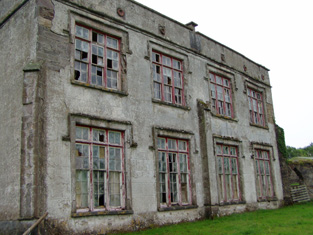
|
| Brook Lodge | The Lord Chancellor is given as the occupier of this house at the time of Griffith's Valuation. The Court of Chancery may have held the property from John Denehy at this time. The buildings were valued at £13. In 1942 the Irish Tourist Association Survey notes that it was once the residence of General Sir Thomas Dennehy and was then owned and occupied by James Scannell. A new house is now located on the site. | |
| Bettyville | The home of the Nason family in the early 19th century, occupied by Richard Nason in 1814 and 1837. By the early 1850s William Corbin was resident holding the house valued at £14.10 shillings from the representatives of Richard Nason. William Corbin was still living at Bettyville in the 1870s. This house is no longer in existence. | |
| Rath-healy | In 1786 Wilson refers to Rath-hely as the seat of Mr. Bryan. It was the home of Arthur Hyde Lucas and his son and namesake in the 19th century. Arthur Hyde Lucas is recorded as occupier at the time of Griffith's Valuation, holding the property from John Hyde when it was valued at £20. In 1880 the property passed to Henry John Lucas, nephew of the second Arthur Hyde Lucas. Sold by the Lucas family in the 1920s and still inhabited. | |
| Careysville | Careysville Castle, originally known as Ballymacpatrick Castle, was the seat of the Carey family from the late 17th century. In 1750 Careysville was occupied by John Carey and Peter Carey was resident in 1814. In 1837 Lewis refers to “the handsome modern mansion built on the site of Careysville castle” by E.K. Carey. Valued at £50 in the mid 19th century the Careys held this property in fee. Inherited by the Montgomerys of Killee and sold by them to the Duke of Devonshire in the mid 20th century. In 1942 the Irish Tourist Association Survey noted that the house was then unoccupied as Captain Montgomery had moved into a modern bungalow nearby. Careysville is now in use as a fishing lodge offering luxury accommodation. |

|
| Glandulane House | Robert Briscoe had a house and flour mill in the townland of Clondulane North in the mid 19th century, which he held from the Earl of Mountcashel. The house was valued at £25.10 shillings and a flour mill at £96. Later the home of the Hallinans and the O'Donnells. A house is still extant at the site but the mill buildings are now ruinous. |

|
| Licklash | Occupied by James Reid in the early 1850s and held from the representatives of Matthew Hendly, the buildings were valued at £18. This house later became a summer home of Sir Oswald Mosley. Also known as Isleclash/Ileclash House. This house was offered for sale in 2010. http://www.michaelhdaniels.com/index.cfm?fuseaction=propdetails&Prop_RefId=24 |
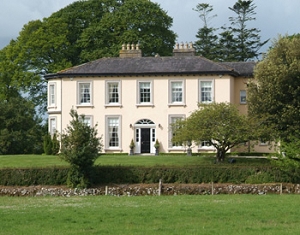
|
| Mountrivers | This house was a Hendley home in the 18th and 19th centuries, occupied by Mathers Hendley in 1814 and Mattias Hendley in 1837. Mattias C. Hendley was resident in the early 1850s. He held the property in fee and the buildings were valued at £27. The Hendleys contined to reside at Mountrivers until the 1930s and the house is still occupied. |
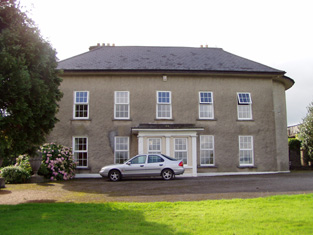
|
| Grange Farm | Originally part of the Forward estate which passed to Garret Nagle who had married the sister of William Forward. Marked on the first Ordnance Survey map as a farm yard by the 1850s James Roderick O'Flanagan was resident in a house valued at £13.5 shillings. He held the property from the representatives of John William Anderson. |

|
| Fermoy House | Lewis refers to Fermoy House in 1837 as the residence of the late J. Anderson “to whom not only the town owes its prosperity but the entire country…”. It was then occupied by Mrs Hennis. The Reverend Maurice Collis was in residence by the time of Griffith's Valuation. He held the property from Sir Robert Abercrombie and the buildings were valued at over £50. In 1786 Wilson writes of a house at Fermoy, the seat of Mr. Bryan. The Irish Tourist Association Survey of 1942 states that Fermoy House was then the property of Maurice Cooke Collis and was divided into five flats. The house was demolished in the 1960s. | |
| Moydilliga/Modeligo | In the mid 19th century this house was the home of Henry Braddell. It was valued at £16 and held by him in perpetuity. Wilson, writing in 1786, refers to it as the seat of Mr. Armstead. By 1906 the mansion house at Moydilliga was valued at £42 and occupied by Henry Braddell. In the early 20th century the property passed to the Haskins-Braddells. Sold by them in 1950, this house is still a family home. |
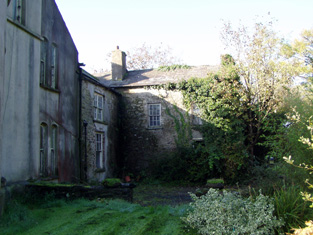
|
| Kilmurry | The house was built in the early 18th century and remained in the hands of the Grant family until sold to the Rosminian Order in the 1930s. In the 1940s the Irish Tourist Association surveyor was given to understand that the Grants still retained title to the property and were residing in South Africa. In the mid 19th century it was valued at £37 and held by Thomas St John Grant in fee. At the beginning of the 21st century this house was in a dilapidated state. |
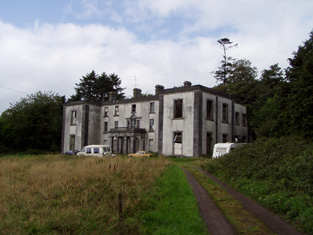
|
| Ballyvolane | Hajba writes that Ballyvolane was bought by Sir Richard Pyne of Waterpark, Lord Chief Justice of Ireland, from the Coppingers in the early 18th century. It remained in the possession of the Pyne family until the mid 20th century and is still occcupied. Valued at £44 at the time of Griffith's Valuation, the house was occupied by Jasper Pine who held it from Thomas, George and Henry Walker. By 1906 the mansion house at Ballyvolane was valued at £70+ and occupied by George M.Pyne. |

|
| Ballyrobert | Hajba writes that Michael Mackay built a house beside the ruined castle of Ballyrobert in the 1820s and he is recorded as resident there by Lewis in 1837. In the early 1850s the house was valued at £23, occupied by Michael Mackay and held from John Peard. Michael J. Mackey occupied the house in 1906. This house no longer exists. | |
| Coole Abbey | This house was the home of a branch of the Peard family until the early 20th century and is still inhabited. It was occupied by Richard Peard in 1814 and by Henry Hawk Peard in 1837. He was still resident in the early 1850s and held the house valued at £36 from James H. Smith Barry. By the end of the 19th century Orr McCausland was the owner of Coole Abbey. |
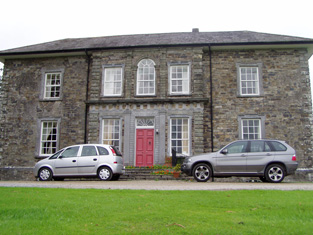
|
| Carrigeen Hall | In 1786, Wilson refers to "Carrygeen" as the seat of Mr. Peard. Hajba writes that this house was the home of Peard Harrison Peard, son of Richard Peard of Coole Abbey and father of Richard Frederick Peard of Belvidere and Henry Peard of Carrigeen. Later the home of the Green and O'Grady families, now demolished. | |
| Sun Lodge | Sun Lodge is marked on the first Ordnance Survey map and was occupied by Denis Hanan in the mid 19th century and held from Henry Peard. It was valued at £30+. Hanan's interest was advertised for sale in 1870. Hajba records various other occupants and this house is still occupied and well maintained. |

|
| Castleview | Castleview was the home of the Gumbleton family held from Henry Peard in the mid 19th century and valued at £68.15 shillings. The house remained in Gumbleton possession until the early 20th century but is now demolished. Bence Jones lists this house under the name Glynnatore and writes that it was built in 1791 by R. W. Gumbleton. In 1894 Slater notes Glenatore as the seat of Mrs. Gumbleton. | |
| Waterpark | Originally a Pyne residence which later passed through marriage to the Cavendishes. In 1786 Wlson refers to "the ruins of Water Park, the seat of the late Lord Chief Justice Pine". Hajba writes that other occupants were the Watkins and Drew families. There was no house of more than £2.10 shillings valuation in this townland, held by George Walker, at the time of Griffith's Valuation. | |
| Mohera | Hajba writes that Michael Mackay was recorded as resident here in 1824. By 1837 John O'Sullivan was resident and was still the occupier at the time of Griffith's Valuation. The buildings were then valued at £14 and the property was held from Major General Conyers. Home of the McAuliffes in the 20th century. |

|
| Rathbarry Cottage | Rathbarry Cottage was occupied by Major William Love Peard at the time of Griffith's Valuation. The property was held from the Reverend R. Gumbleton and the buildings were valued at £11. Some ruined walls remain at the site. | |
| Towermore | The home of Mrs Maria Oliver in 1837 but leased to Frederick C. Hayes in the early 1850s. The house was valued at £45. Maria was the widow of Charles S. Oliver of Inchera and a daughter of A. Morris of Dunkettle. A. Morris Oliver is recorded as a subscriber to Lewis ''Topographical Dictionary'' published in 1837 but is not mentioned in Burkes. Earlier, in 1786, Wilson refers to Tormore as the seat of Mr. Connor. This house was not occupied at the end of the 20th century although still extant. | |
| High Park | Occupied by the Reverend J. W. Edgar in 1837 and by Bridget Hogan in the mid 19th century, valued at £12+ and held from William Coppinger. This house no longer exists. | |
| Baneena | John Ross occupied a house at Baneena North valued at £11.10 shillings in the mid 19th century. He held the property from Abraham Devonsher. This house is not surrounded by a demesne on the first Ordnance Survey map. | |
| Mountain Lodge | Originally a shooting lodge of the Devonshers, it was the home of Abraham John Devonsher in the mid 19th century. He held the property valued at £3 in fee. It is now a ruin. | |
| Hollyhill | David Hallahan occupied Holy hill, Rathcormack, in 1814 and S. Croker in 1837. Eliza Croker held the property from Francis C. Reeves in the mid 19th century, when the buildings were valued at £11.10 shillings. [for this Croker family see http://members.iinet.net.au/~nickred/croker_research/The_Irish_CROKER.pdf page 121]. Later the home of the Campion and other families, this house is no longer extant. | |
| Ballyglissane | A Reeves home held from the Devonsher family, occupied by F.G. Reeves in 1837 and by Edward Reeves in the early 1850s when the buildings were valued at £30+. Later the home of the Warren family and still a family residence. |

|
| Mellefontstown | The main residence of the Nason family in the 18th century, John Nason was resident in 1814 and Pierce Cotter in the early 1850s. Cotter held the property from Thomas Wise and the buildings were valued at £19+. In May 1863 Pierce Joseph Cotter's estate at Mellifontstown, containing the house, demesne and 246 acres was advertised for sale. It was held on a lease dated 1852 from Francis Wise to Pierce Cotter for 185 years. A new house now stands on the site. | |
| Scartbarry | Home of the Wilson family in the 19th century, occupied by Edward Wilson in 1814 and by Ellen Wilson in the early 1850s, when the house was valued at £11 and held from James H.S. Barry. Edward Wilson of Scartbarry owned 26 acres in the 1870s. This house is still a family residence. The interest of the descendants of the Wilson family of Scartbarry and of James Milner Barry in the lands of Skehannagh and Coolequane, barony of Barrymore were offered for sale in the 1850s. |

|
| Ballyready | A house located on the Devonsher estate, occupied by Patrick Bourke in 1814. The house was valued at £12.10 shillings and occupied by John Fetnam at the time of Griffith's Valuation. It is still a family home. | |
| Ballynahina | Ballynahina was a Barry home inhabited by Philip Barry and his wife Mary Ann at the end of the 18th century. Lewis refers to Gerard Barry at Ballinahina House and Reverend Dr Barry, Parish Priest of Fermoy for half a century, at Ballinahina Cottage. Edward Barry was resident at Ballynahina, valued at £11, in the early 1850s. He held the property from Gerald Barry. This house is still extant. |
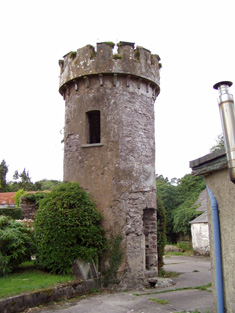
|
| Bride Villa | Hajba writes that this building was originally a coach inn. By the time of Griffith's Valuation Edward Barry a doctor was resident. He held the property valued at £14.15 shillings from Viscount Riversdale. This house is stil inhabited. |
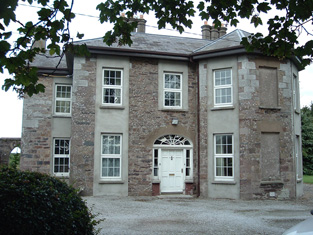
|
| Lisnagar | Originally a home of the MacAdam branch of the Barry family, sold to the Lawless brothers in the 1770s and soon afterwards bought by William Tonson. In 1786 Wilson refers to the seat of Lord Riversdale, close to Rathcormack. The house was occupied by the Reverend John Bolster in the early 1850s and valued at £39.15 shillings. Slater refers to it as the seat of W.A.S. Riversdale in 1894. William Alcock-Stawell succeeded to this property in 1861 and took the additional name of Riversdale. Lisnagar was sold in the early 20th century. This house is still a residence. |

|
| Terramount | A mid 19th century house, home of John G. Nason in the early 1850s. Held by him in fee and valued at £24.25 shillings. The Nasons owned this property until the early 20th century. The famous race horse Dawn Run was bred at Terramount in the 1970s. |
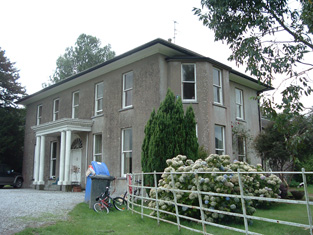
|
| Newtown | Newtown House was inherited by the Nasons through marriage with a Harrison heiress in 1716. It continued to be the main seat of one branch of the Nason family until the end of the 19th century. Still in Nason occupation in 1906 when the buildings were valued at £13. Only some ruined walls now remain. | |
| Newtown Lodge | Another Nason residence, occupied by Henry Nason in the mid 19th century and held from John Nason, the buildings were valued at £21. It remained in Nason possession until the early 20th century. This house is still a family residence. |
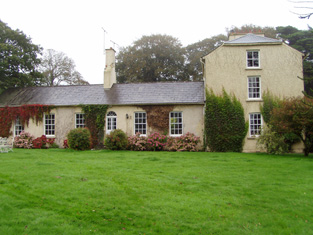
|
| Ballymacsimon | A house located on the Devonshire estate and occupied by John Kirby in the mid 19th century. The buildings were valued at £25. William Kirby held 2 townlands in the parish of Aghera at the time of Griffith's Valuation. Home of the Collins family in the mid 20th century and still inhabited. | |
| Booladurragha South | William O'Neill was occupying a house in this townland at the time of Griffith's Valuation, the buildings were valued at £15+ and the property was held from the Duke of Devonshire. The Duke is given as the occupier of this house in 1906. A house still exists at this site. Boulta House now functions as a guest house. |
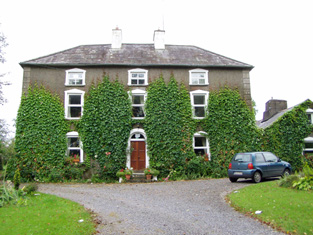
|
| Bride Park | Hajba writes that the Reverend Stephen Rolleston built this house in the 1770s. In 1814 it was inhabited by the Reverend Spread and in the mid 19th century by Thomas Power who held it from Mrs Elina Greaves and others. The buildings were valued at £20+. Bride Park remained the home of the Power family until the early 20th century. This house has recently been renovated and restored. |

|
| Carrigmore | Richard Power was resident here in 1814 and Edward Morragh in the mid 19th century. Morragh held the property from the Duke of Devonshire and the buildings were valued at £18+. Later the home of the Cronin family. Hajba writes that this house has been unoccupied since 1990. | |
| Thornhill | A Nason home, first occupied by John William Washington Nason. His widow Mrs Barbara Nason is recorded as resident at the time of Griffith's Valuation. Valued at £18.11 shillings the house was held from the Duke of Devonshire. The Nason family continued to live here until the mid 20th century. The house is still an occupied residence. | |
| Killavarilly | At the time of Griffith's Valuation John O'Neill, a doctor, held a house valued at £25+ and 350 acres from the Duke of Devonshire at Killavarilly. A house is still located at this site. | |
| Mogeely House | A house on the Devonshire estate, occupied by Charles H. Walsh in the mid 19th century and valued at £25.18 shillings. Later the home of the Des Barres and Kent families. Slater refers to it as the seat of Lt-Col. Des Barres in 1894. Still a family residence. It is labelled Mogeely Castle on the 1st edition Ordnance Survey map but as Mogeely House on the later editions, |
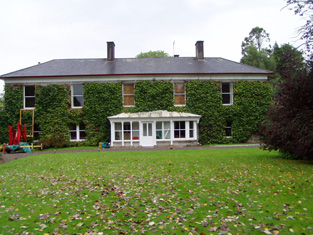
|
| Lisnabrin Lodge | Occupied by Thomas Carew in 1837 and by Sands Bellis who held the house and 28 acres from Thomas Carew in the mid 19th century. The buildings were valued at £36+. This house is extant, occupied and well maintained. |

|
| Woodview | Woodview was the home of the Reverend George Nason in 1837 and in the early 1850s was occupied by his son Charles Nason who held the property from Major Edward Croker [Lisfinny]. The buildings were valued at £13+. This house is still a family residence. | |
| Ballinterry | Hajba writes that this property had passed from the Terrys to the Earls of Barrymore at the beginning of the 18th century. In 1814 it was the residence of the Reverend John Ross and in 1837 of Archdeacon Ryder. The Archdeacon was still resident at the time of Griffith's Valuation when the buildings were valued at £21. It now operates as a luxury guesthouse. |

|
| Dundullerick House | Occupied by J[ames] Barry in 1837 and by his son William Barry in the early 1850s. The property was held in fee with 353 acres and the buildings were valued at £26+. William's nephew James William Creagh Barry later purchased Dundullerick. | |
| Dundullerick | This house was occupied by Edmund Barry in the mid 19th century, when it was valued at £16+ and held in fee. Edmond married in 1836 Sarah Isabella daughter of Pierce Creagh of Rockforest Lodge. Their grandson sold Dundullerick to his cousin James William Creagh who took the additional name of Barry. This house appears to have remained in Creagh Barry possession until the 20th century. \in 1906 valued at £19.10 shillings and occupied by Pierce Barry. | |
| Clonmult | The Powers appear to be associated with Clonmult from the late 17th century. In the first half of the 19th century Pierce Power was resident, the house being valued at £23 in the early 1850s and held from Edward Phayre. A Shaw Smith home in the second half of the 19th century. Louis K. Smyth is recorded as the occupant in 1906 when the buildings were valued at £16. 15 shillings. |
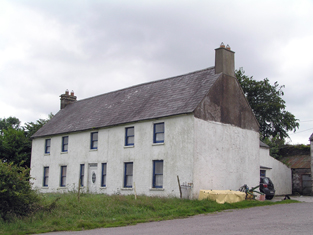
|
| Caherduggan | In 1786, Wilson refers to "Carduggan" as the seat of Mr. Davis. Denis O'Callaghan was living at Cadogan (Caherduggan) by 1837. He held the property in fee at the time of Griffith's Valuation when it was valued at £48. This house remained in the possession of the O'Callaghan family until the 20th century. It is still extant but unoccupied. |

|
| Leadinton | The home of the Atkin family for most of the 18th and 19th centuries. In 1786 Wilson refers to it as the seat of Mr. "Arkin". Valued at £16.15 shillings at the time of Griffith's Valuation, it was occupied by the Reverend Joseph Wright and held from J.T. Atkins Swanne. | |
| Castlelyons House | Situated on 2 acres in the centre of the town of Castlelyons this house was in the possession of the related clerical families of Browne and Ryder in the 18th and 19th centuries. Occupied by the Reverend Joshua B. Ryder in the mid 19th century. He held the property valued at £30 from Samuel Perrott. Still valued at £30 this house was occupied by the representatives of Andrew W. Ryder in 1906. |

|
| Berry Hill | The National Inventory of Architectural Heritage states that this house dating from circa 1700 was a dower house for the Barrymore family of Castlelyons Castle. By the mid 19th century it was in the possession of the Perrott family and occupied by the Reverend Philip Berry who held the buildings valued at £21 with 15 acres. This house is still occupied. |
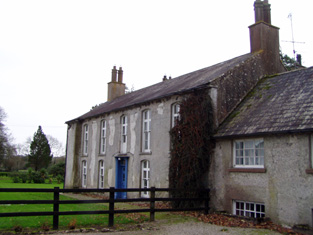
|
| Hunting Fort | A house valued at £10 occupied by Patrick Keneiry and held by him with 338 acres from the Duke of Devonshire in the mid 19th century. A building is still extant at this site. | |
| Peafield (Templemodan) | In 1786 Wilson refers to Peafield as the seat of Archdeacon Mockler. There is no substantial house shown in this area on the 1st edition Ordnance Survey map. By the time of Griffith's Valuation, the townland was in the possession of Thomas Boyce. | |
| Castle Lyons | Wilson, writing in 176, refers to the accidental burning of the seat of the Earls of Barrymore. "The mansion house, with the furniture and a valuable collection of pictures, were entirely destroyed by an accidental fire". Some ruins remain at the site. A dower house, built by the Barry family towards the end of the 18th century, is still extant and known as Berryhill. . |

